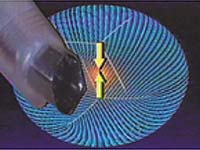Preset phaco parameters allow surgeons to switch surgical maneuvers
A few preset modes can be applied to the changing needs of any patient.
Click Here to Manage Email Alerts
Surgeons need to experiment with their phaco settings in order to achieve the best possible results, now that technology allows surgeons to individualize their techniques, said Roger Steinert, MD.
"We have this spectacular technology now that's computer driven, and we have the capability of dramatically increasing safety for the patient and making it a much less traumatic procedure for the eye," Dr. Steinert said. "The challenge we have as surgeons is to learn which of these works best for our techniques."
The number of points on the decision tree have escalated to the point that it takes a long time to reach a decision, he said. Gone are the days when the sales rep could quickly teach the surgeon how to use new equipment.
"We've had our Sovereign (Allergan, Irvine, Calif.) units for a few months short of a year, and I still haven't tried all the possibilities," Dr. Steinert said. "It makes it fun, but a challenge as well."
Preset modes
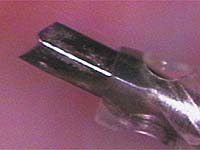 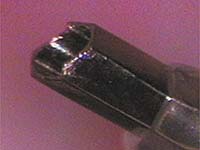 Using the LensQuake Phaco, parameters allow the surgeon to crack the nucleus from the center to the periphery without needing to place a sharp chopping instrument near the lens equator. |
To perform phaco, Dr. Steinert uses four preset modes on his unit, based on the grade of cataract he is removing. Preoperatively, he grades the estimated nuclear density based on age and nuclear brunescence. He bases the amount of vacuum on the grade of cataract.
At grade 1, he sets his vacuum at 100 mm Hg; at grade 2, 200 mm Hg, and so forth.
"I do not change flow, because the Sovereign unit has stable fluidics that can maintain high flow even at high vacuum," Dr. Steinert said. "However, I will raise the IV pole progressively with higher levels of vacuum."
His first preset mode is for sculpting the nucleus, and his second preset mode is for the bulk of nuclear phaco. Preset mode 3 is for another optional setting based on his surgical maneuvers during phaco, and preset mode four is for the epinucleus.
In mode 4, he will lower the vacuum to 160 mm Hg and increase the flow to as much as 40 cc/min. Allergan has an occlusion mode built into the computer controls, so the machine will automatically switch when the tip occludes.
"You could be running a high flow with no occlusion — 40 cc/min — and when it's in occlusion, it would drop to 24 cc/min," Dr. Steinert said. "Some people like to do that because they feel that there's extra safety."
The Sovereign unit offers one other preset variable for the way that ultrasound is delivered. Six different ways exist to deliver the energy in what is called the power matrix, which offers a range of choices.
Dr. Steinert said he prefers the low-power pulse. This mode offers a pulsing system that uses short and lower energy bursts at a more rapid pace. The next mode delivers longer, more forceful pulsing but with bigger spacing in between, and the final mode is continuous phaco.
There is also conventional burst mode, single burst and high-powered pulse modes.
A study that Dr. Steinert has presented at several meetings shows that for a 3+ dense nucleus, low-powered pulse cuts the amount of intraocular energy by half compared to conventional continuous phaco.
This mode reduced the level of energy needed to that used to emulsify a 2+ nucleus, "which should translate into more friendliness to the endothelium, less striae and better visual acuity."
LensQuake method
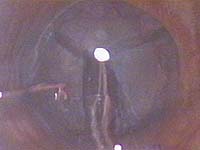 --- Three-way LensQuake that propagated along all branches of the Y-suture simultaneously.
--- Three-way LensQuake that propagated along all branches of the Y-suture simultaneously.
Jack A. Singer, MD, uses phaco presets to perform LensQuake Phaco. His surgery applies a hexagon-shaped phaco tip to induce a disturbance in the lens nucleus, which simulates a miniature earthquake. With this technique, phaco parameters allow the surgeon to crack the nucleus from the center to the periphery without the need to place a sharp chopping instrument near the lens equator.
The crystalline lens is composed of annular concentric layers of radial fibers that join at the anterior and posterior y-sutures, which are encountered at times during central sculpting or during slit lamp examination of the lens. These natural fault lines correspond to these radial layers that are added though life. So the lens not only has concentric layers but also has radial cleavage planes, which can be used for LensQuake.
To perform LensQuake, Dr. Singer uses the Ocusystem Advantage (Surgical Design, Long Island City, N.Y.) with phaco parameters of power of 10% to 50% with linear on, flow rate of 36 cc/min to 44 cc/min with linear on, vacuum limit of 200 mm Hg to 500 mm Hg with linear on and an adjustable rise time with an activation point of 60 mm Hg, the point at which the secondary flow rate kicks in, and a secondary flow rate of 3 cc/min active only in foot switch position 2.
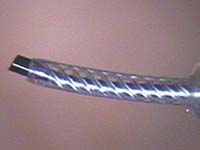 --- Singer LensQuake tip with 15° curve and 15° bevel up.
--- Singer LensQuake tip with 15° curve and 15° bevel up.
"Using the above TriLinear settings, higher levels of vacuum up to 500 mm Hg are achieved only when higher ultrasound power levels are needed to emulsify dense lens material, which is precisely when ultra-high vacuum is needed most," Dr. Singer said. "If the lens material occluding the phaco tip is soft, then the occlusion will be broken at low ultrasound power with a corresponding low vacuum limit."
When the tip is not occluded, a flow rate of 36 cc/min provides good followability. In foot switch position 2, when the tip is occluded and vacuum rises to 60 mm Hg or higher, the flow rate automatically drops to 3 cc/min in order to slow the vacuum rise time.
When the surgeon feels it is safe to proceed to higher levels of vacuum, the foot switch is advanced into the beginning of position 3, which cancels the adjustable rise time setting and increases the flow rate to 36 cc/min. This speeds the vacuum rise, he said. After the vacuum reaches 200 mm Hg, the foot switch is advanced further into position 3 to add ultrasound and vacuum until the lens material is fragmented and aspirated.
"Ultra high flow up to 44 cc/min is achieved only when higher ultrasound power levels are needed to emulsify dense lens material, which helps maintain good followability and prevents lens chatter at times of high cavitation energy," Dr. Singer said. "I call this SmartFlow, which works automatically in the background."
Using TriLinear settings lets the surgeon do the entire case without switching between programmed settings. Each segment can be emulsified and aspirated as it is freed up by the LensQuake maneuver, which minimizes the number of free nuclear segments at any one time. This reduces the chance that nuclear segments will dislocate into the vitreous if the posterior capsule tears, Dr. Singer said.
Consensus procedure
 --- Singer LensQuake tip with hexagon shape induces a disturbance in the lens nucleus that simulates a miniature earthquake.
--- Singer LensQuake tip with hexagon shape induces a disturbance in the lens nucleus that simulates a miniature earthquake.
Vacuum-driven procedures have almost become a consensus, according to Paul H. Ernest, MD.
He has developed a method of nuclear disassembly designed to be as safe as possible to the posterior capsule.
"By staying within the capsulorrhexis border and not going underneath the edge of the anterior capsule, I do not run the risk of catching the anterior capsule and splitting it," Dr. Ernest said. "Then, by going to a 60º depth, there is no way you're going to get close to the anterior capsule."
Initially, his vacuum is set at between 60 mm Hg and 100 mm Hg just to clear viscoelastic but not engage the nucleus. He uses the ABS handpiece and Legacy 20000 (Alcon, Ft. Worth, Texas), which allows him to employ his vacuum levels between 400 and 500 mm Hg, flow rates at 45 cc/min and power at around 60%."I use very little power. I rely mostly on vacuum to remove the nucleus, and then the power is used only to assist the vacuum," he said.
The bulk of his nuclear disassembly is done with forceps under viscoelastic.
"I'm not as deep and not as peripheral, and that's safer to the capsule as a whole," Dr. Ernest said. "As for using vacuum instead of power to remove the nucleus, I also use the bimodal mode on the Legacy. This allows me to have surgeon-assisted vacuum to remove the quadrant. And by using vacuum more than power, I have less chatter and less damage to the corneal endothelium. I rarely have to do a chop because the vacuum is high enough to control and remove the quadrants easily."
He also keeps his bottle at about 100 mm, in order to maintain depth and stability of the anterior chamber.
He will lower the bottle in patients with a previous vitrectomy or those with high myopia to reduce the tension on the zonules."
One standard method
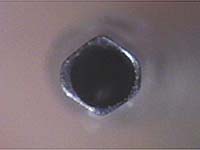 ---Singer LensQuake tip with external hexagon shape and circular lumen. Dr. Singer says that it reduces the chance that nuclear segments will dislocate into the vitreous if the posterior capsule tears.
---Singer LensQuake tip with external hexagon shape and circular lumen. Dr. Singer says that it reduces the chance that nuclear segments will dislocate into the vitreous if the posterior capsule tears.
Louis D. Nichamin, MD, uses chop techniques, specifically the vertical quick chop technique with the Millennium unit (Bausch & Lomb Surgical; Claremont, Calif.).
He said that with this particular machine, his settings are rarely adjusted in the conventional sense.
"The equipment is very good today," Dr. Nichamin said. "We're constantly trying to tweak the fluidics and use a lot of different settings, specifically for the particular stage of surgery or situation that exists. For me, part of the goal toward utmost efficiency has been settle into one general setting (maximum vacuum) and then titrate flow and vacuum 'on the fly,' so to speak, utilizing the dual linear foot pedal. This allows real time linear control of both phaco power and fluidics. The marriage between equipment and refined surgical technique has come to this confluence of simplicity."
His phaco parameters apply to 95% of lenses. He uses a Microseal tip and sets his machine at 175 mm Hg. He uses dual linear control as needed. If he needs more vacuum, he moves the dual linear pedal and increases vacuum to 200 mm Hg.
He sets his power at 40% for all but the densest lenses. For rock-hard nuclei, debulking is first performed with power of 80% to 100% and vacuum of 50 mm Hg.
"We applaud these types of refinements that permit a more simple approach," Dr. Nichamin said.
Variable parameters
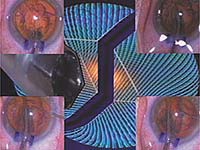 ---Slide the nucleus manipulator downward along the side of the stationary phaco tip and then move the phaco tip slightly forward and the nucleus manipulator slightly backward to produce a strike-slip fault, sliding the nuclear segments past each other horizontally. This will induce complete propagation of the lensquake to the posterior pole and to the equators.
---Slide the nucleus manipulator downward along the side of the stationary phaco tip and then move the phaco tip slightly forward and the nucleus manipulator slightly backward to produce a strike-slip fault, sliding the nuclear segments past each other horizontally. This will induce complete propagation of the lensquake to the posterior pole and to the equators.
The Millennium Concentrix Technology is based on the scroll pump. According to Terence M. Devine, MD, this technology is unique in that it can be configured to operate in vacuum-based venturi-like modes or flow-based peristaltic-like modes and switched back and forth between modes for each step of a procedure. The Millennium also is unique, he said, in its ability to simultaneously monitor both vacuum and flow rate. This advanced technology then offers surgeons the ability to preset multiple parameters to custom tailor the machine to each step of their individual procedure based on variables such as cataract density and pupil size. With so many options however, a user-friendly interface is essential, or the technology and choices could be overwhelming, Dr. Devine explained.
He primarily uses the vacuum-based mode with the dual linear foot pedal to perform "phaco flip" for softer lenses and a modified "stop and chop" technique for denser lenses or small pupil cases. He describes the dual linear foot pedal with multi-mode programming as the key to efficiently utilizing this technology.
"Most users can benefit from the machine's ability to switch back and forth between modes," Dr. Devine said. "Peristaltic" users like to have a panel setting for a low flow rate of about 15 cc/min for sculpting. Flow is what determines followability, so low flow is safer for sculpting near iris or capsule, he said.
|
|
"If surgeons are using divide and conquer, for example, they may want to switch to a higher flow rate of 30 cc/min to 35 cc/min to increase followability to draw quadrants to the tip and work more efficiently," Dr. Devine said.
For maximum efficiency, however, Dr. Devine's preference is to use linear vacuum between 50 mm Hg and 300 mm Hg. When the tip is open the dual linear foot pedal controls vacuum in the collection cassette, but the surgeon actually is controlling linear flow in the eye between 17 cc/min and 46 cc/min.
When the tip is occluded, flow stops and vacuum migrates to the tip to provide "holding force" and "aspiration power" between 50 mm Hg to 300 mm Hg.
"I use what I call trilinear control, which is linear control of power, linear flow when the tip is open and linear vacuum when the tip is occluded," Dr. Devine continued, "I can use those same settings regardless of whether I'm doing phaco flip or divide and conquer. You have such flexibility that you can get any response you want from the machine without changing panel settings. You're controlling everything with your foot."
Although his phaco parameter settings are the same for each patient, his use of flow and vacuum changes for each case. Before speaking with Ocular Surgery News, Dr. Devine had performed 28 phaco cases that morning. He used the same settings for all 28, but in each case he would use the linear power, flow and vacuums differently to match what was happening in the eye. His last patient, for example, had a very narrow angle and a small pupil from angle-closure glaucoma. With very little working space he used the dual linear foot pedal to titrate flow and followability to avoid catching iris — he never used the maximum flow of 46 cc/min.
"At the other extreme, a case with a soft lens and large pupil allows me to use very high flow and vacuum to remove the lens with more aspiration and lower ultrasonic power. The ability to instantly adjust flow and vacuum up or down allows us to use higher levels than would be possible as panel settings," Dr. Devine said. "If we had to set a panel setting for the speed of our car, it could only be as fast as was safe for the most dangerous part of the road. A linear gas pedal allows us to adjust speed for changing conditions and at times go faster than a panel setting would permit. This is the true advantage of dual linear control. It gives us greater flexibility to work faster, safer and more efficiently."
For Your Information:
- Roger F. Steinert, MD, can be reached at Ophthalmic Consultants of Boston, 50 Standiford St., Ste. 600, Boston, MA 02114; (617) 367-4800; fax: (617) 573-4912. He is a paid consultant for Allergan.
- Jack A. Singer, MD, can be reached at 40 S. Main St., Randolph, VT 05060; (802) 728-2460; fax: (802) 728-3407.
- Louis D. Nichamin, MD, can be reached at the Laurel Eye Clinic, 50 Waterford Pike, Brookville, PA 15825; (814) 849-8344; fax: (814) 849-7130. Dr. Nichamin does not have a direct financial interest in any of the products mentioned in this article. He is medical monitor for Bausch and Lomb Surgical.
- Terence M. Devine, MD, can be reached at RD 2 Box 184E, Athens, PA 18810; (717) 888-5858; fax: (717) 882-3236. Dr. Devine has no direct financial interest in any of the products mentioned in this article. However, he is a paid consultant for Bausch & Lomb.
- Paul H. Ernest, MD, can be reached at the TLC Eye Care Center of Michigan, 1116 W. Ganson St., Jackson, MI 49202; (517) 782-9436; fax: (517) 782-3001.

